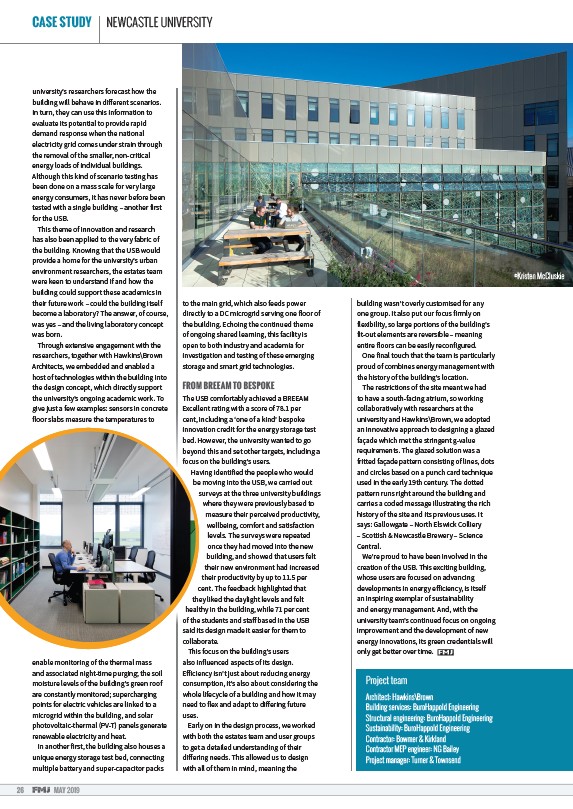
CASE STUDY NEWCASTLE UNIVERSITY
university’s researchers forecast how the
building will behave in di erent scenarios.
In turn, they can use this information to
evaluate its potential to provide rapid
demand response when the national
electricity grid comes under strain through
the removal of the smaller, non-critical
energy loads of individual buildings.
Although this kind of scenario testing has
been done on a mass scale for very large
energy consumers, it has never before been
tested with a single building – another first
for the USB.
This theme of innovation and research
has also been applied to the very fabric of
the building. Knowing that the USB would
provide a home for the university’s urban
environment researchers, the estates team
were keen to understand if and how the
building could support these academics in
their future work – could the building itself
become a laboratory? The answer, of course,
was yes – and the living laboratory concept
was born.
Through extensive engagement with the
researchers, together with Hawkins\Brown
Architects, we embedded and enabled a
host of technologies within the building into
the design concept, which directly support
the university’s ongoing academic work. To
give just a few examples: sensors in concrete
floor slabs measure the temperatures to
enable monitoring of the thermal mass
and associated night-time purging; the soil
moisture levels of the building’s green roof
are constantly monitored; supercharging
points for electric vehicles are linked to a
microgrid within the building, and solar
photovoltaic-thermal (PV-T) panels generate
renewable electricity and heat.
In another first, the building also houses a
unique energy storage test bed, connecting
multiple battery and super-capacitor packs
26 MAY 2019
to the main grid, which also feeds power
directly to a DC microgrid serving one floor of
the building. Echoing the continued theme
of ongoing shared learning, this facility is
open to both industry and academia for
investigation and testing of these emerging
storage and smart grid technologies.
FROM BREEAM TO BESPOKE
The USB comfortably achieved a BREEAM
Excellent rating with a score of 78.1 per
cent, including a ‘one of a kind’ bespoke
innovation credit for the energy storage test
bed. However, the university wanted to go
beyond this and set other targets, including a
focus on the building’s users.
Having identified the people who would
be moving into the USB, we carried out
surveys at the three university buildings
where they were previously based to
measure their perceived productivity,
wellbeing, comfort and satisfaction
levels. The surveys were repeated
once they had moved into the new
building, and showed that users felt
their new environment had increased
their productivity by up to 11.5 per
cent. The feedback highlighted that
they liked the daylight levels and felt
healthy in the building, while 71 per cent
of the students and sta based in the USB
said its design made it easier for them to
collaborate.
This focus on the building’s users
also influenced aspects of its design.
E iciency isn’t just about reducing energy
consumption, it’s also about considering the
whole lifecycle of a building and how it may
need to flex and adapt to di ering future
uses.
Early on in the design process, we worked
with both the estates team and user groups
to get a detailed understanding of their
di ering needs. This allowed us to design
with all of them in mind, meaning the
building wasn’t overly customised for any
one group. It also put our focus firmly on
flexibility, so large portions of the building’s
fit-out elements are reversible – meaning
entire floors can be easily reconfigured.
One final touch that the team is particularly
proud of combines energy management with
the history of the building’s location.
The restrictions of the site meant we had
to have a south-facing atrium, so working
collaboratively with researchers at the
university and Hawkins\Brown, we adopted
an innovative approach to designing a glazed
façade which met the stringent g-value
requirements. The glazed solution was a
fritted façade pattern consisting of lines, dots
and circles based on a punch card technique
used in the early 19th century. The dotted
pattern runs right around the building and
carries a coded message illustrating the rich
history of the site and its previous uses. It
says: Gallowgate – North Elswick Colliery
– Scottish & Newcastle Brewery – Science
Central.
We’re proud to have been involved in the
creation of the USB. This exciting building,
whose users are focused on advancing
developments in energy e iciency, is itself
an inspiring exemplar of sustainability
and energy management. And, with the
university team’s continued focus on ongoing
improvement and the development of new
energy innovations, its green credentials will
only get better over time.
Project team
Architect: Hawkins\Brown
Building services: BuroHappold Engineering
Structural engineering: BuroHappold Engineering
Sustainability: BuroHappold Engineering
Contractor: Bowmer & Kirkland
Contractor MEP engineer: NG Bailey
Project manager: Turner & Townsend
©Kristen McCluskie